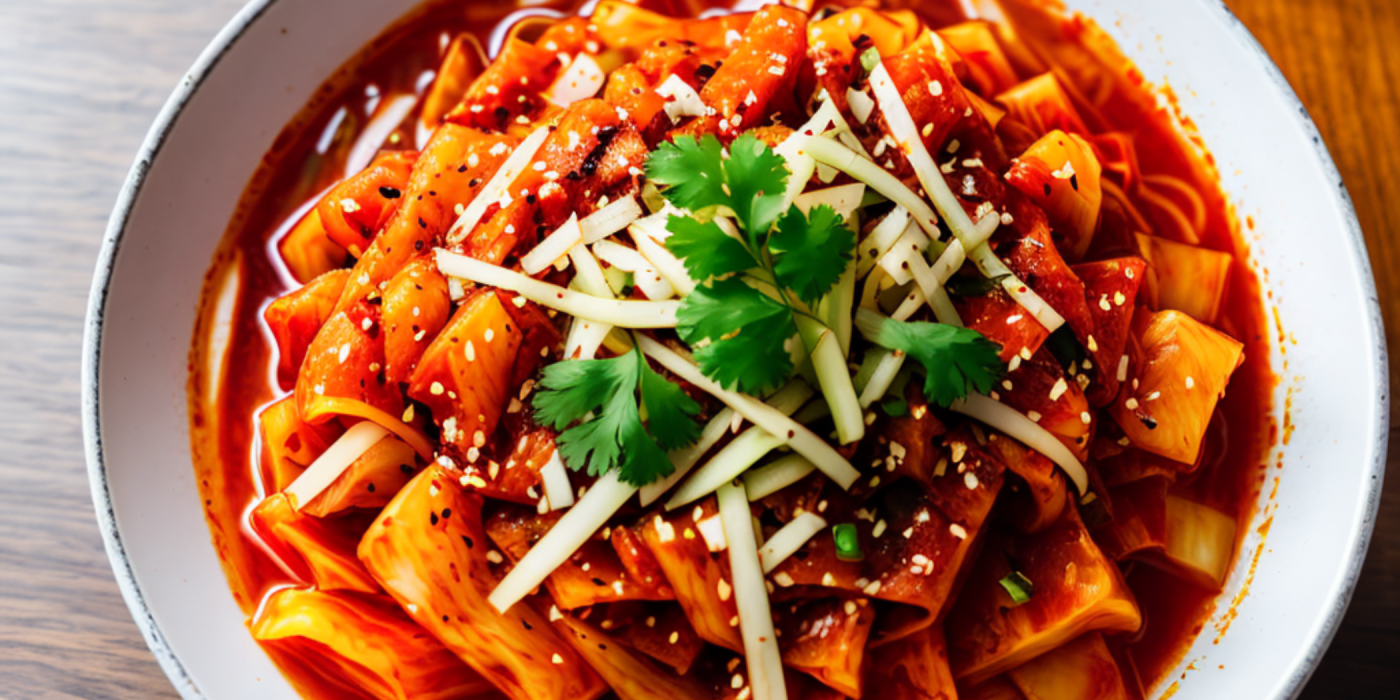The Ultimate Guide to Kimchi: Nutrition, Health Benefits and a Classic Recipe

Welcome to a tantalising journey into the heart of Korean cuisine, featuring a star player renowned for its spicy punch and nutritional prowess: kimchi. This traditional fermented dish has carved out a significant spot in the realm of healthy eating, captivating taste buds and benefiting bodies worldwide.
Unveiling the Kimchi Chronicles
From its humble beginnings in Korea, kimchi has evolved into a global sensation, a testament to the worldwide love for bold flavours and gut-friendly probiotics. This article will unfold the intriguing world of kimchi, unveiling its distinct nutritional profile, substantial health benefits, and also provide a traditional recipe to help you get started with making your own batch at home.
Whether you're a devoted kimchi connoisseur seeking to deepen your understanding or a curious novice eager to explore this fermented marvel, our comprehensive guide will satisfy your appetite for knowledge. We'll break down kimchi's nutritional composition, delving into the specifics of its vitamins, minerals, and probiotics content. From there, we'll examine the health benefits associated with regularly consuming kimchi, highlighting its potential role in digestion, immunity, and weight management.
For the culinary enthusiasts among you, our easy-to-follow, traditional kimchi recipe will be a treat. Complete with tips for storage and usage, you'll soon be on your way to crafting your own delicious, nutritious batches of homemade kimchi.
Intrigued? Read on, and let's embark on this kimchi adventure together.
Getting to Know Kimchi
Kimchi is a traditional Korean side dish that has earned a place on the global culinary stage due to its unique flavours and considerable health benefits. It is primarily made from salted and fermented vegetables, with the most common variant involving Chinese cabbage (napa cabbage) mixed with a seasoning paste composed of chilli pepper, garlic, ginger, and a variety of other flavourful ingredients. The resulting product is a spicy, tangy, and slightly sweet delicacy that enhances virtually any meal it accompanies.
A Peek into the History of Kimchi
The origins of kimchi can be traced back to ancient Korea, where the fermentation technique was developed as a means to preserve vegetables for the harsh winter months. The word "kimchi" is derived from the Korean term 'chimchae', which means 'salting of vegetables'.
Over the centuries, kimchi has evolved significantly, with various regional variations emerging across Korea. Each region has its unique twist on the dish, using different vegetables and seasonings to create a myriad of flavours. Today, it is estimated that there are over 100 types of kimchi, each with its distinctive taste profile and preparation method.
The Cultural Significance of Kimchi in Korea
In Korean culture, kimchi holds a place of high esteem and is deeply intertwined with the nation's food heritage. The process of making and sharing kimchi, known as 'kimjang', is considered a time-honoured tradition and a communal event. In 2013, UNESCO even added kimjang to its list of intangible cultural heritage, underscoring the cultural and historical importance of kimchi in Korea. Today, kimchi is not just a staple food item in Korea; it symbolises Korean culinary tradition and continues to gain popularity worldwide.
A Deep Dive into the Nutritional Profile of Kimchi
Kimchi is a nutritional treasure trove that offers a wide array of vitamins, minerals, and other essential nutrients. In this section, we'll explore the nutrient composition of this distinctive Korean staple.
Macronutrients in Kimchi
Kimchi is low in calories and rich in dietary fibre, making it an excellent choice for those who are watching their calorie intake. It also contains some protein and carbohydrates, providing your body with the energy it needs to function properly.
Vitamins in Kimchi
Kimchi is known for being a good source of vitamins A, B, and C. Vitamin A is necessary for good vision and a healthy immune system. The B vitamins found in kimchi, such as B1 (thiamine) and B2 (riboflavin), play a crucial role in maintaining a healthy metabolism. Furthermore, due to the fermentation process, kimchi is rich in vitamin C, which is not only a powerful antioxidant but also vital for the growth and repair of all body tissues.
Minerals in Kimchi
When it comes to minerals, kimchi packs a hefty punch. It contains calcium for bone health, iron for red blood cell formation, and potassium which helps to regulate fluid balance and nerve signals in the body.
Probiotics in Kimchi
Last but not least, kimchi's fermentation process leads to the growth of beneficial bacteria, also known as probiotics. These can improve digestive health and contribute to a stronger immune system.
In essence, kimchi is a nutrient-dense food that can contribute to a balanced diet and support overall health.
Health Benefits of Kimchi
Kimchi is not just a staple of Korean cuisine; it's also a food brimming with health benefits. It contains several properties that can contribute to improved wellbeing, owing to its probiotics and wealth of nutrients. Let's delve into these benefits in more detail.
Digestive Health Improvements
One of the key health benefits of kimchi is the positive impact it has on digestive health. Kimchi is fermented, which means it's rich in probiotics, beneficial bacteria that contribute to a healthy gut. These probiotics assist in the digestion process, helping to break down food and absorb nutrients more effectively.
Immune System Enhancements
Kimchi is packed with vitamins A and C, both of which are essential for a robust immune system. Vitamin A plays a critical role in maintaining the health of your skin and mucous membranes, the body's first line of defence against pathogens. Vitamin C, meanwhile, is an antioxidant that helps protect your body's cells from harmful free radicals.
Anti-inflammatory Properties
The process of fermenting kimchi produces certain bioactive compounds that can help reduce inflammation in the body. This includes indole-3-carbinol, which has been found to suppress inflammation markers in scientific studies.
Potential Weight Loss Benefits
Kimchi's high fibre content and low calorie count make it a beneficial food for weight management. Fibre can help you feel fuller for longer, potentially reducing overall calorie intake. Some research also suggests that the probiotics in kimchi could help reduce body fat. However, more research is needed in this area to fully understand these effects.
Remember, while kimchi has many potential health benefits, it should be part of a balanced diet and healthy lifestyle for optimum benefits.
Recommended Daily Amount of Kimchi
Kimchi, like other fermented foods, is rich in nutrients and probiotics, which are beneficial to our health. However, one should also keep in mind that it can be quite high in sodium due to the pickling process.
Daily Intake for Adults
For adults, incorporating about one to two servings, equivalent to roughly 30 to 60 grams of kimchi, into your daily diet can be beneficial. This recommended intake can provide a good balance of the beneficial probiotics and nutrients, whilst keeping the sodium levels within check.
Daily Intake for Children
For children, it is advised to start with smaller quantities due to kimchi's robust flavour and potential spiciness. A suggested amount might be a serving of around 15 to 30 grams per day. Before introducing kimchi or any fermented foods into a child's diet, it's always best to consult with a paediatrician.
Incorporating Kimchi into Your Diet
There are several ways to include kimchi in your diet. Traditionally, it's served as a side dish with Korean meals, but its versatility extends beyond its cultural roots. Here are a few suggestions:
- Serve kimchi as a condiment alongside your main meal.
- Add it to your stir-fries for an added kick and depth of flavour.
- Use kimchi in your sandwiches, wraps, or even burgers for a tangy twist.
- Incorporate it into your salads for an exciting new layer of taste.
- Stir into your soups or stews to enrich the broth with complex flavours.
Remember, moderation is key. While kimchi is indeed a healthy food, it should be a part of a balanced diet, paired with a variety of other nutritious foods.
Crafting Homemade Kimchi
Creating kimchi at home might seem daunting due to its rich, complex flavour, but don't fret. The process is quite straightforward, and the result is a delicious, healthful addition to your meals.
Traditional Kimchi Recipe
To make your own kimchi, you'll need napa cabbage, daikon radish, scallions, garlic, ginger, Korean red pepper flakes (gochugaru), fish sauce, and salt. The preparation process begins by salting and soaking the cabbage to soften it, followed by creating a spicy paste with the other ingredients. This paste is then mixed with the cabbage, radish, and scallions, creating a delightful mix of flavours.
- Cut the napa cabbage into quarters, removing the core. Salt each leaf, ensuring even distribution. Leave it for 1-2 hours until it softens.
- Rinse the cabbage thoroughly to remove excess salt. Drain well.
- Create the spicy paste by blending garlic, ginger, fish sauce, and gochugaru.
- Add finely sliced daikon radish and scallions to the paste, mixing well.
- Apply the paste to the cabbage, ensuring every leaf is coated.
- Pack your kimchi tightly into a clean jar, leaving some space at the top.
- Allow it to ferment at room temperature for 1-2 days, then move it to the fridge.
Storing and Using Homemade Kimchi
Keep your kimchi in a tightly sealed jar in the fridge to maintain its freshness. It can last for several months but will continue to ferment over time, altering its taste. As a staple in Korean cuisine, kimchi can be used in a variety of dishes, including stews, fried rice, pancakes, and even as a pizza topping. Enjoy exploring its versatility!
Wrapping Up on Kimchi
In this journey through the world of kimchi, we've explored the multifaceted aspects of this traditional Korean food, which offers more than just a unique flavour profile. It's a remarkable source of nutrients, loaded with vitamins, minerals, and probiotics that are beneficial to our health.
Kimchi, comprised mainly of fermented cabbage and various spices, brings with it a dense concentration of vitamins A, B, and C, which support immune function and overall health. Furthermore, its mineral content, including calcium, iron, and potassium, contribute to the maintenance of many vital body functions.
The rich probiotic content in kimchi cannot be overlooked. These beneficial bacteria, often linked with fermented foods, contribute significantly to our digestive health, potentially assisting with issues like inflammation and even playing a role in weight management.
Then we dived into the world of homemade kimchi, demonstrating that it's entirely possible, and indeed rewarding, to make your own batch at home. This process not only allows you to appreciate the traditional Korean culinary practices but also enables you to adjust the recipe to your liking.
So, why not give kimchi a go? Whether you choose to incorporate it into your favourite sandwich, serve it as a side dish, or experiment with it in your kitchen, kimchi has the potential to transform your culinary experiences and offer a boost to your health. Embrace the tang, the spice, and the zest of kimchi, and let your taste buds embark on a new adventure.
Your Kimchi Queries Answered
What does kimchi taste like?
Kimchi offers a unique blend of flavours that can be described as tangy, spicy, and slightly sour. This distinct taste is a result of the fermentation process and the spices used, including chilli pepper, garlic, and ginger.
Can you eat kimchi raw?
Absolutely, kimchi is typically consumed raw, allowing you to fully enjoy its textures and flavours, as well as maximising its beneficial probiotics. It's also often added to dishes like soups and stews for an extra kick.
How do you store kimchi?
Proper storage is key to maintaining the taste and nutritional quality of your kimchi. Store it in an airtight container in the fridge to slow down the fermentation process and preserve its flavour. Remember to always use a clean utensil when serving to avoid contamination.
How long does homemade kimchi last?
Homemade kimchi can last several weeks to months when properly stored in the fridge. However, its taste and texture will evolve over time. Some people prefer the sourer flavour of older kimchi, especially for use in cooked dishes.
Is kimchi suitable for people with dietary restrictions (e.g., gluten intolerance, veganism)?
Traditional kimchi recipes may include fish sauce or shrimp paste, which are not suitable for vegans. However, there are vegan-friendly versions that use plant-based alternatives. As for gluten intolerance, while kimchi itself doesn't contain gluten, be mindful of cross-contamination or potential gluten sources in store-bought versions. Always check the label if you're following a specific diet.
Related to this article are the following:
- Natto Knowledge: Nutrition, Health Benefits, and a DIY Recipe Guide
- Tempeh Treasure: Health Benefits, Nutritional Profile, and a Simple Recipe
- Miso Demystified: Nutritional Insights, Health Gains, and a Homemade Recipe
- The Ultimate Kefir Guide: Nutrients, Health Benefits, Recipe and More
- A Deeper Dive into the World of Vitamins: Spotlight on Vitamin C
I do hope you have enjoyed this article and hope that you will subscribe to my newsletter so you can get the latest information about all things naturally relaxing.
Stay in touch, join the Naturally Relaxing Newsletter
Newsletter Signup
Post Your Comments
or post as a guest
Be the first to comment.
Latest articles in Food

Hot Cross Buns This Easter: A Timeless Tradition of Baking and Sharing

Chocolate Krispie Cakes for Easter: A Simple, Festive Treat for All

2023 Christmas Culinary Delights: Recipes for the Ultimate Festive Feast

Embrace Autumn with the Best Pumpkin Spice Recipes in the UK

Turning Pumpkin Carvings into Pumpkin Pie: A British Culinary Tradition






